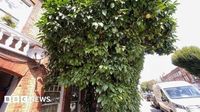On a leafy stretch of Queenstown Road in Battersea, south-west London, a pair of subtropical grapefruit trees now stand as more than just an unlikely sight—they have become a living memorial and a symbol of community heritage, thanks to a determined campaign by local residents and friends. The trees, believed to be among the very few of their kind growing outdoors in the United Kingdom outside of Kew Gardens, were granted a Tree Preservation Order (TPO) by Wandsworth Council in early August 2025, ensuring their protection for generations to come.
The story of these remarkable trees begins over forty years ago, when Marline Anderson, a vibrant member of the local community, moved from Grenada to Battersea. In the 1980s, seeking to bring a piece of her homeland with her, Marline arrived with a tiny grapefruit sapling in tow. She planted it in the front garden of her council flat. Over the decades, the sapling flourished—growing to an impressive 30 feet and, as it turns out, being joined by a second grapefruit tree. Together, they became a lush, green landmark on Queenstown Road, bearing fruit year-round and drawing curious glances from passersby.
But these trees were more than just botanical oddities. For Marline and her neighbors, they represented a deep connection to home, heritage, and nature. According to BBC, the grapefruit trees were a rare sight in the UK, with the Royal Horticultural Society (RHS) noting that citrus trees like these typically struggle to survive outdoors through British winters. The RHS describes the grapefruit as "a slow-growing evergreen shrub with glossy green leaves," producing fragrant white flowers and, in rare cases like this, large, round fruit that ripens over the course of 12 months after spring or summer flowering.
Marline Anderson sadly passed away in June 2025, leaving behind a legacy that extended far beyond her immediate family. Her final wish was for her ashes to be scattered beneath the grapefruit trees she had lovingly tended for decades. As her friend and neighbor Vasilisa Ermakova told The Guardian, "It’s almost like she will live for ever in my eyes." The trees, Ermakova explained, were not just about fruit—they were about memory, continuity, and the bonds that tie a community together.
Concern quickly grew among local residents about the fate of the trees. The flat and the garden belonged to Wandsworth Council, raising fears that future residents or developers might seek to remove the trees. Lior Berman, a local chef and friend of Marline, spearheaded a campaign to secure legal protection for the trees. She reached out to the council, emphasizing not only their rarity but also their significance to the neighborhood’s identity and mental well-being. "You want to have a relationship and a connection to nature. When you have a healthy, mature tree that produces fruit in the city, you want to protect it as much as you can," Berman told The Guardian. She added that the fruit had found its way into her kitchen as marmalade, and even the leaves could be used for tea or hair washing—a testament to the trees’ versatility and value.
The campaign resonated with many in the area, who described the trees as "a brilliant landmark" and a tangible link to the Windrush generation’s contributions to Wandsworth. As BBC reported, residents had previously voiced their fears that the trees might be chopped down, which would mean the loss of something truly special. The council responded by conducting a Tree Evaluation Method assessment, ultimately confirming that the trees were eligible for a preservation order.
On August 7, 2025, Kemi Akinola, Deputy Leader of Wandsworth Council, arrived at Marline’s former home to announce that an interim Tree Preservation Order had been granted, with full approval pending a 28-day consultation period. The order prohibits cutting down, lopping, topping, uprooting, or otherwise destroying the trees without explicit council permission. Akinola expressed pride in the decision, stating, "We were very pleased to grant the Tree Preservation Order and ensure that this beloved local landmark stands for generations to come. Marline was much-loved by her neighbours and we’re proud to have listened to the wishes of the community." She added, "In our year as London Borough of Culture, it’s great to recognise the contribution that people of African and Caribbean heritage have made to Wandsworth."
The council’s move was also part of a broader initiative to record and honor the history of the Windrush generation in the borough. As Akinola told The Guardian, "We’re trying to record the history of our Windrush generation at the moment. Because, otherwise, once they go, the stories will go." The preservation of the grapefruit trees thus stands as both a practical and symbolic gesture—a way to keep Marline’s story, and the stories of so many others, alive for future generations.
To mark the trees’ new status and Marline’s enduring influence, a memorial plaque was installed outside her former house. The plaque, inscribed with her birth and death dates (January 19, 1948 – June 11, 2025), reads: "A gift from her homeland, Grenada. It bears fruit year-round, her essence lives on in its roots." There’s also a gentle request from Marline herself: "Kindly refrain from picking from the tree. You are welcome to gather what nature has let fall." According to BBC London reporter Anna O’Neill, who tasted the fruit just before the protection order was granted, the grapefruit was "delicious"—a small but fitting tribute to Marline’s green thumb.
The emotional weight of the preservation is not lost on Marline’s friends and neighbors. Ermakova described her feelings as "happy, but a little bittersweet because, obviously, she’s not here to see it. And she would have really loved to have known it would be protected." She added, "If we can drive down here in 50 years and see the tree, then that will be quite phenomenal." Marline, who was known affectionately as "Mum" by many in her community, left behind not just three children but a whole street of friends who saw her as family.
As the consultation period for the full Tree Preservation Order continues, the grapefruit trees of Queenstown Road stand as a testament to the power of community action, the importance of honoring cultural heritage, and the simple, profound joy of seeing something rare thrive in an unexpected place. Their story, rooted in love and remembrance, will live on in every branch and blossom for decades to come.




